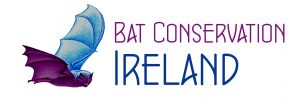The main aim of Bat Conservation Ireland is to help conserve Irish bats. In order to ensure Irish bats are being conserved it is important to know to find out how their populations are doing, in other words, whether they are increasing, decreasing or stable. Regular monitoring is the key to picking up any declining (or increasing) trends, which are in turn, important in forming conservation policy and management on a nationwide and EU level. BCIreland manages four schemes to track trends in bat populations. All four schemes are managed under contract to the National Parks and Wildlife Service (NPWS) of the Department of Arts, Heritage and the Gaeltacht, and additional funding is provided for the two all-island schemes by the Northern Ireland Environment Agency.
All-Ireland Daubenton’s Bat Waterways Survey
Fancy becoming a citizen scientist? The All-Ireland Daubenton’s Bat Waterways Survey is the most popular scheme among members of the public and those new to bat survey work. Free training courses are held across the island in July every year to train in new survey teams. Training just takes two hours on a summer’s evening. If you can’t make a training course, we have lots of online training facilities that you can avail of. The survey itself takes place twice in August. We need YOU to volunteer for this important conservation work. It is easy to carry out and BCIreland has a library of bat detectors available for loan to teams who don’t have one.
Car-based Bat Monitoring
This project has been running since 2003. For this scheme volunteers drive known routes in 28 locations across the island and record all bat sounds along the roadside using time-expansion bat detectors. The survey takes place in July and August. Bat sounds are analysed by BCIreland after the survey has been completed. The species monitored using this scheme are the common pipistrelle, soprano pipistrelle and Leisler’s bat. Some information on Nathusius’ pipistrelle is also collected from the survey. In recent years surveyors have been using smartphones to record bat sounds, which means that bat locations can be determined using the GPS co-ordinates.
Brown Long-eared Bat Roost Monitoring
This project uses counts of individual bats within, or emerging from, brown long-eared bat roosts to determine the trends in this species’ population. The scheme has been running since 2007. A combination of volunteers, roost owners and BCIreland staff carry out these counts twice in the summer season.
Lesser Horseshoe Bat Roost Monitoring
This is the longest running bat monitoring scheme on the island. Counts at lesser horseshoe bat roosts have been carried out at selected sites in counties along the western seaboard by staff of the NPWS since the 1980s. BCIreland has recently taken over management of this scheme which is, for the most part, carried out by staff of NPWS and the Vincent Wildlife Trust.
BATLAS 2020
The BATLAS 2010 project vastly increased our knowledge of bats throughout the country and filled in many gaps where no bats had been recorded for the first decade of the 21st Century. We are repeating the BATLAS survey from 2016-2019 now, find out more




